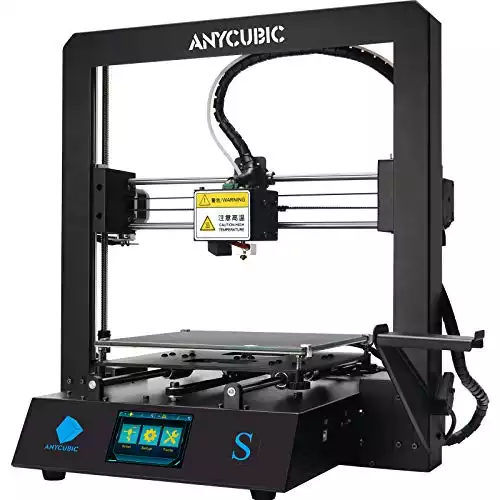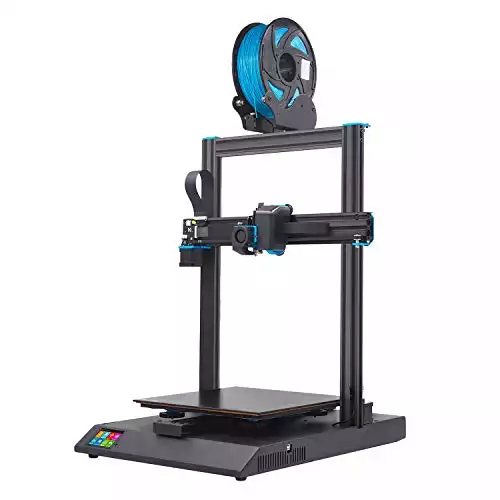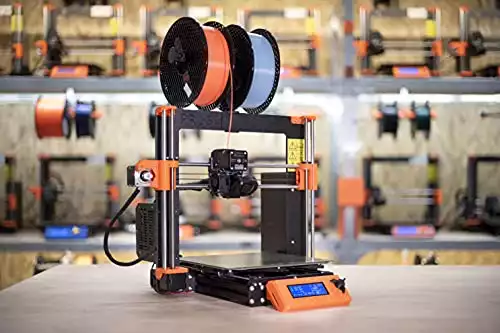- Flashforge Creator 3 Review [2022]: Our Honest Opinion - April 5, 2022
- Anycubic Photon Review [2022]: Will This Work for You? - April 5, 2022
- X-Carve Review [2020]: Is This CNC Machine Right For You? - April 4, 2022
Imagine you’re rolling through the McDonald’s drive-thru and you order a Big Mac, fries, and a Coke. Classic order. Good on you. Now, you ask them to supersize it. Because you simply can’t get enough of the greasy goodness.
Apply this logic to the Anycubic Mega S. That’s what Anycubic did when they made the Mega X. It’s like a supersized Mega S, with all the same great features in a bigger package. It’s a mid-sized FDM printer that’s definitely worth your money.
Are you looking for a great 3D printer that rings up at less than $500 and meets, or even surpasses your expectations? Then you may have come to the right place.
No assembly hassle, get started quickly. Provides better printing experience, compatible with TPU.
Table of Contents
Anycubic Mega X Specifications
- Technology: FDM
- Weight: 14kg
- Printer dimensions: 500mm x 500mm x 553mm
- Arrangement: Cartesian XZ head
- Build volume: 300mm x 300mm x 305mm
- Feeder system: Bowden drive
- Extruder type: Single
- Maximum extruder temperature: 250°C
- Nozzle size: 0.4mm
- Layer resolution: 0.05-0.3mm
- Print chamber: Open
- Print Bed: Heated bed with Anycubic Ultrabase
- Bed leveling: Manual
- Maximum heated bed temperature: 90°C
- Frame: Metal
- Display: Color touchscreen
- Connectivity: USB, SD card
- Wi-Fi: No
- Built-in camera: No
- Filament sensor: Yes
- Filament diameter: 1.75mm
- Materials: PLA, ABS, HIPS, wood
- Third party filaments: Yes
- Slicer: Cura
- Operating systems: Windows, Mac, Linux
Anycubic Mega X Setup
The Anycubic Mega X only comes semi assembled, but putting it together is pretty simple. It’s packed neatly in the box and the instructions identify exactly what everything is and how to attach it. You can view the instructions via a paper manual or the USB stick provided.
Anycubic provides clippers and a spatula, as usual, but the Mega X also ships with a 1kg spool of PLA. Spare parts include PTFE tubing and a hot end.
Assembly mostly includes mounting the gantry on the base with a few screws. Connect some cables together, set the MeanWell PSU switch to the correct voltage, and you’re done in minutes.
Before printing, you’ll have to level the bed manually. The printer has large adjustment knobs that make this task rather trivial. You can auto-home the print head and adjust the knobs as needed, leveling with just a sheet of paper.
Some budget 3D printers use tiny knobs to achieve the task of leveling, making it really difficult, so in comparison, the Anycubic Mega X makes it boring, but easy. There’s no need to endure the torture of small, hard to reach knobs anymore.
Anycubic Mega X Features
Anycubic gained some market traction at the low end with their i3 Mega and then followed it with an improved version in the Mega S. After gaining user trust, they kept the same design and ease of use they knew worked but improved the scale with the Mega X.
Compact, smart design
The base unit of Mega X includes the mainboard, power supply, and touchscreen. The cable management is neat, which is a welcome change compared to a lot of other budget units that come with wads of cables all jumbled together.
The metal frame offers a robust, sturdy chassis. The Z-axis features led screws and the Y-axis carriage runs along dual rails, supporting the bed, and making the entire structure even more steady.
This printer has a solid foundation that offers consistent printing. Not only is this rarely found in the budget price point, but the Mega X also features dual Z-axis end stops. It can combat unevenness you may find in the X-axis and relevels the X-axis every time it returns home.
It has mechanical end stops on the X-axis, but it uses a contactless sensor for the Y-axis end stop. This offers a more premium design that maintains a look and feel far above its price point.
Anycubic Ultrabase
The Anycubic Ultrabase has set the precedent for many bases to imitate. It’s a 300mm x 300mm bed sitting on top of four screws for manual leveling. While it’s roomy, it’s also innovative. This glass bed is coated with a porous material that offers excellent adhesion while making it easier than ever to remove your jobs when they’re complete. It’s especially unique when printing with PLA.
It can heat to 60°C in two minutes with a maximum temperature of 90°C. It also does a fantastic job of distributing this heat across the entire surface, enabling effective adhesion for quality prints without huge flaws.
This is exceptional for large print surfaces, especially when it comes to preventing warping. It can still be a problem when printing with ABS, but it’s to be expected when the temperature maxes out at only 90°C.
Single extruder
This single Titan extruder has a hot end capable of a maximum of 250°C. It uses PTFE tubing to help filament navigate its way to the melt zone. It’s nearly impossible to print hotter than this without getting off-gas of the PTFE, which can be toxic.
This is more than hot enough for consumer materials, so it’s a fantastic strong extruder in a budget 3D printer. You should have no problem using Mega X at around 245°C with PETG, which is a high temperature material.
The downside to Anycubic filament holders is that they stick out sideways on the bottom. While it takes some of the weight off of the frame, it means the filament gets fed upside down.
This, combined with the filament runout sensor, which is mounted on the side of the gantry, means the filament is constantly strained. However, thanks to a feeding mechanism that works well, you’ll get continuous feeding.
It just takes some working with to change the filament, because it’s inserted upside down. Thanks to the plastic funnel that Anycubic provides, you can easily guide your filaments into the gear mechanism.
Rigid filaments are much easier to insert than flexible filament ones, as you might expect.
Connectivity
One of the most important things about 3D printing is your ability to oversee the print process, even when you’re not actively designing your print. With a 3.5-inch color touchscreen (something you more frequently see on higher end 3D printers), you have all of the options you need.
The menu can be somewhat confusing, but the software has everything you need to set up the printer just the way you want it. You can load your prints via a USB cable or an SD card onto the Anycubic Mega X.
Unfortunately, aside from what’s already been mentioned, there’s nothing new over the Mega S. Given that there’s a few years difference in release date, many users are disappointed by the lack of updates here when it comes to Wi-Fi, quieter printing, or auto bed leveling.
Performance
If you’ve had any experience with the Mega line before, you know that they produce great results for the price you pay. You’ll see this theory confirmed in Mega X, too.
Just like any other budget 3D printer, you’ll likely have to make some adjustments to get your Mega X to function properly. However, that’s not uncommon.
Thanks to the Anycubic Ultrabase, your prints will adhere well and easily pop off when they’re done. This adds to your overall experience by making it more seamless throughout. The best thing about it is you don’t have to use glue, which makes it a messy and less than a desirable affair.
It leaves your print surface looking like it did when you took it out of the box, but it also gives your print projects smooth first layers for an aesthetically pleasing result every time.
Mega X can handle many different materials, but it’s all based on your technical settings. While some flexible filaments will come out flawlessly, others will tangle up in the gear mechanism helplessly.
You’ll have to adjust the print and feed print speed accordingly to get to a manageable flow without any backing up or coiling. It can be a bit of trial and error, which is excruciating at times, but once you get there, it handles almost anything like a champ.
Unfortunately, you may never find a way around the warping of ABS. No matter how much you change the temperature or fan settings, the Mega X just isn’t suited for something as finicky as this temperature sensitive material.
The upside is that it still handles PETG and PLA well, so you’re not limited in your choice of materials.
No assembly hassle, get started quickly. Provides better printing experience, compatible with TPU.
Usability
Mega X allows you to use any open source slicer. While Cura remains one of the most popular options, you can use anything you’re comfortable with, which opens up the usability of the machine quite nicely, although Anycubic recommends Cura.
While the UI can be confusing, the menu items are large and easy to read. You may find at times that the submenus are unclear and contain tools that don’t seem to belong. The button press sound can also be quite obnoxious.
And while the Mega X is a sturdy machine, it’s also a noisy one. The Z-axis screws are the most deafening, but they only move when homing at the beginning of the print. The other aspects of the printer aren’t particularly quiet, either, from the drivers to the cooling fans.
The filament runout sensor works well, and once reloaded, the print job will pick up where it left off without any problems. The downside here is that it’s a mechanical sensor that will only trip with a lack of filament, rather than a costly optical sensor that will trigger with a filament blockage.
The print resume function works less than ideally. Sometimes it resumes the print after a power outage, and sometimes it doesn’t, leaving you to start your job over from scratch.
Anycubic Mega X Alternatives
If you’re seriously considering a budget 3D printer like the Anycubic Mega X, you may also want to take a look at the following options before making a buying decision.
Anycubic Mega S
This previous iteration sports the same sturdy build and nearly identical features. The build volume is about two-thirds the size, at 210mm x 210mm x 205mm, an 3d it’s quite a bit cheaper, too.
It’s a great option if you don’t mind the smaller print volume but you want all of the same features. You really won’t miss a thing and your wallet will be a little fatter from the cash you saved.
3 steps to set up ANYCUBIC Mega S 3D printer with 8 screws and 3 cables for minutes, not only meets fast assembly needs for expert users but also friendly use to beginners.
Artillery Sidewinder X1
The Sidewinder X1 was Artillery’s first attempt at a 3D printer. It’s another budget solution with a sleek look, but it has a bigger build volume of 300mm x 300mm x 400mm. It also has a direct drive system.
While the print quality out of the box isn’t quite as good as the Mega X, it can be really great for a budget solution if you spend some time getting the settings just right. Plus, with the exceptional print volume, you really won’t find much else in this price range that offers quite as much.
Artillery Sidewinder X1 is a all-in-one cartesian 3D printer with ultra quiet stepper drivers, direct drive extruder, dual Z axis, AC heated bed, TFT touch screen.
Original Prusa i3 MK3S
This printer is slightly more expensive but still rings up at under $1000. However, it has almost everything you’d ever want right out of the box. It heats up quickly, has a flexible metal build plate, and features a direct drive system.
The excellent print quality leaves little to be desired, and the automatic bed leveling makes setup a breeze. You’ll get a really great value out of this printer, so while it may not be a budget solution per se, it might just be the best option on the list.
Basic features magnetic PEI Spring steel sheet EINSY RAMBo Base plate Silent Trinamic drivers with 256 microstepping Maximum travel speed: 7.874 in per second. The Original Prusa i3 MK3S+ is the latest version of their award-winning 3D printers.
Honorable Mentions: I also considered…
- Anycubic Mega Zero
- Anycubic Mega Pro
- Anycubic Mono X
- Anycubic Photon S
- Anycubic Chiron
FAQs
It’s really cool learning how to print in 3D, but not everyone may find it valuable. You can spend a lot of time and money on it and it may not end up being worth it for you, resulting in a huge strain on your budget.
Thankfully, budget 3D printers offer a great entry point into the world of 3D printing, so you can get your feet wet before spending too much money. Any of the 3D printers here are great budget options for you if you’ve never done it before.
Sometimes you can sell items you make with your 3D printer and you can even use your at-home 3D printer as a commercial services on websites like Hubs. Just list it as a service or take orders for prints.
Just remember that poor quality items and printers won’t make as much money, so it’s probably not a good idea to do it with a budget printer. However, if you upgrade to a more professional device, this may be an option.
3D printing is fun, but there are always disadvantages. In the world of budget 3D printing, one of the main disadvantages is a lack of features. You’re not going to find the build volume or the range of materials that you would find in a more expensive, professional quality printer.
You’re also not going to get the same high quality results. Design inaccuracies will leave you with imperfect prints, and if you’re not careful, you can struggle with copyright issues.
If you’re looking at building a quality 3D printer made out of high performance parts, it’s generally cheaper to buy the parts individually and build it yourself. However, if you’re entering the 3D printing world at the budget level, you’re better off spending a few hundred bucks on a budget printer.
You have to keep in mind that building a 3D printer isn’t easy. You have to get the right components and know what you’re doing, or the printer won’t work. It’s a big time commitment, and if you’re going to but a cheap 3D printer, it’s well worth spending the money to save yourself the time.
The Verdict – Anycubic Mega X: Worth it?
The Mega X is a great, large volume budget 3D printer. The Anycubic Ultrabase gives you a seamless experience all around while the print quality may just exceed your expectations.
It has a sleek appearance with a sturdy build. Despite the price, they chose not to include any cheap parts. Plus, with steel construction, once you set up the printer, there’s no need to go back and readjust it later.
The large touchscreen makes it easy to use and the ability to use your own choice of open source software open up its usability to anyone who has their own personal preferences.
It doesn’t differ much in terms of features from the Mega S and it would have been nice to see some improvements like auto bed leveling and Wi-Fi connectivity, but for those who like the Mega series and want the extra build volume, it’s a great option.
- Top Anyycubic 3D printers
- Anycubic i3 Mega vs Ender 3
- Anycubic Photon vs Photon S
- How to Find the Best Resin Printer

![Anycubic Mega X Review [2022]: Should You Go For It?](https://total3dprinting.org/wp-content/uploads/2020/10/image-1-5.jpg.webp)









